Human Resource Management Report: Employee and Labor Relations
VerifiedAdded on 2022/09/18
|12
|2593
|27
Report
AI Summary
This report provides a comprehensive overview of Human Resource Management (HRM), encompassing critical aspects such as employee competence management through training and development, and managing employee behaviors and attitudes to foster a productive work environment. It delves into the complexities of labor unions, including their history, government regulations, and various types, along with the processes of union organization, collective bargaining, and grievance resolution. Furthermore, the report explores the creation of high-performance HR systems, focusing on principles like shared information and quality-reward linkages, and tools like employment portfolio management and HR scorecards to evaluate system effectiveness. The report concludes by highlighting the importance of employee diversity and maintaining positive labor relations as key trends in contemporary HRM, emphasizing how these factors contribute to gaining a competitive advantage in today's dynamic business landscape.
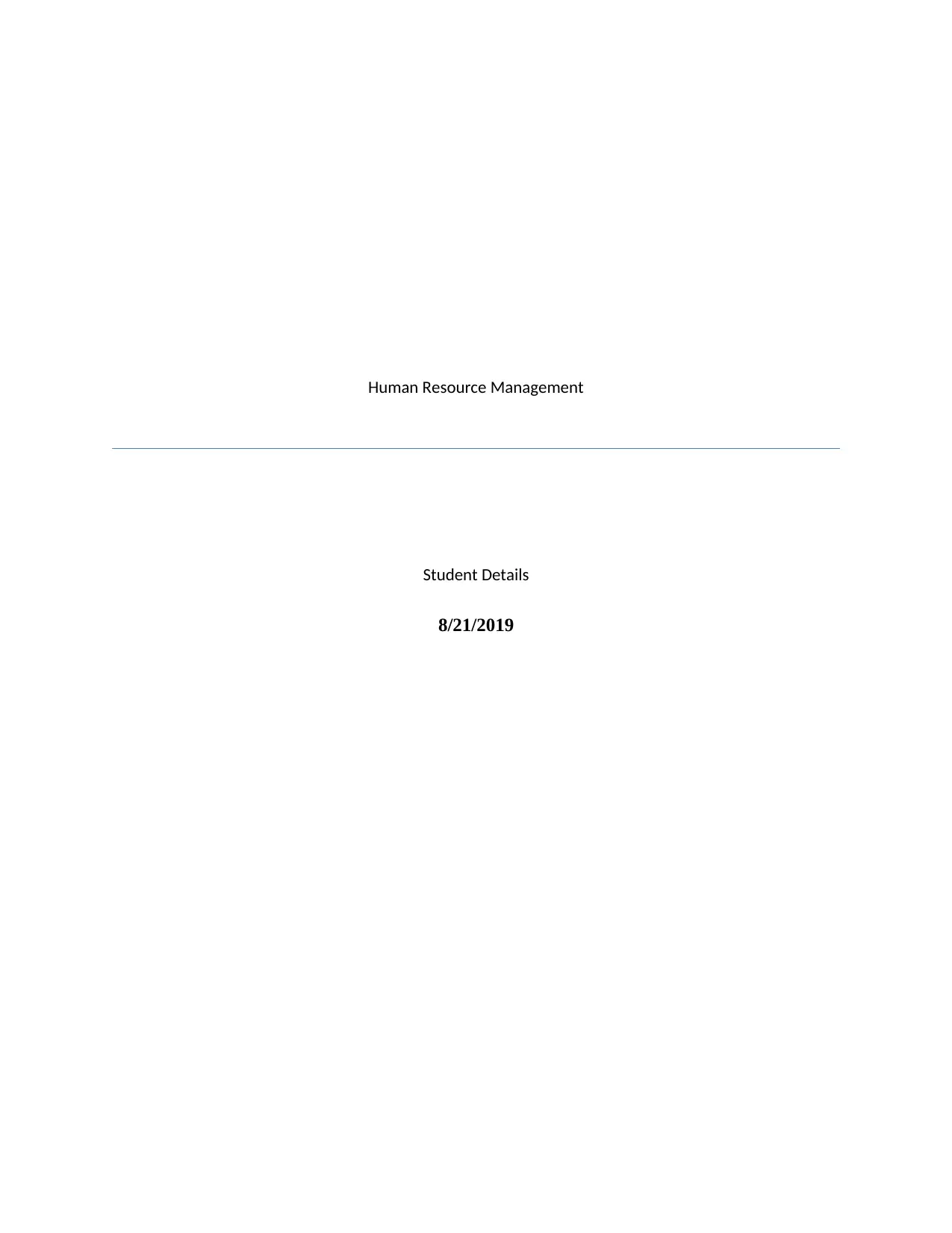
Human Resource Management
Student Details
8/21/2019
Student Details
8/21/2019
Paraphrase This Document
Need a fresh take? Get an instant paraphrase of this document with our AI Paraphraser
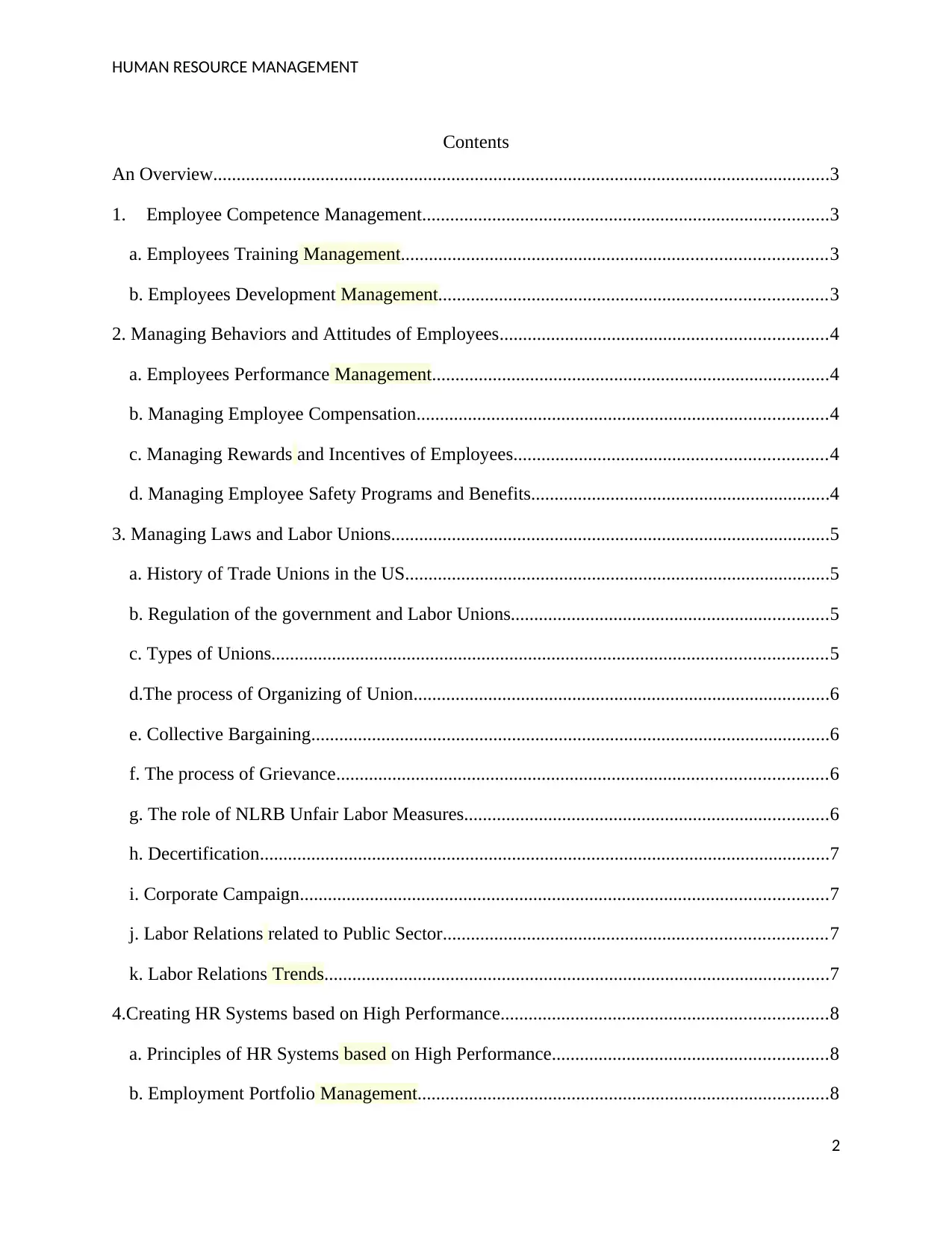
HUMAN RESOURCE MANAGEMENT
Contents
An Overview....................................................................................................................................3
1. Employee Competence Management.......................................................................................3
a. Employees Training Management...........................................................................................3
b. Employees Development Management...................................................................................3
2. Managing Behaviors and Attitudes of Employees......................................................................4
a. Employees Performance Management.....................................................................................4
b. Managing Employee Compensation........................................................................................4
c. Managing Rewards and Incentives of Employees...................................................................4
d. Managing Employee Safety Programs and Benefits................................................................4
3. Managing Laws and Labor Unions..............................................................................................5
a. History of Trade Unions in the US...........................................................................................5
b. Regulation of the government and Labor Unions....................................................................5
c. Types of Unions.......................................................................................................................5
d.The process of Organizing of Union.........................................................................................6
e. Collective Bargaining...............................................................................................................6
f. The process of Grievance.........................................................................................................6
g. The role of NLRB Unfair Labor Measures..............................................................................6
h. Decertification..........................................................................................................................7
i. Corporate Campaign.................................................................................................................7
j. Labor Relations related to Public Sector..................................................................................7
k. Labor Relations Trends............................................................................................................7
4.Creating HR Systems based on High Performance......................................................................8
a. Principles of HR Systems based on High Performance...........................................................8
b. Employment Portfolio Management........................................................................................8
2
Contents
An Overview....................................................................................................................................3
1. Employee Competence Management.......................................................................................3
a. Employees Training Management...........................................................................................3
b. Employees Development Management...................................................................................3
2. Managing Behaviors and Attitudes of Employees......................................................................4
a. Employees Performance Management.....................................................................................4
b. Managing Employee Compensation........................................................................................4
c. Managing Rewards and Incentives of Employees...................................................................4
d. Managing Employee Safety Programs and Benefits................................................................4
3. Managing Laws and Labor Unions..............................................................................................5
a. History of Trade Unions in the US...........................................................................................5
b. Regulation of the government and Labor Unions....................................................................5
c. Types of Unions.......................................................................................................................5
d.The process of Organizing of Union.........................................................................................6
e. Collective Bargaining...............................................................................................................6
f. The process of Grievance.........................................................................................................6
g. The role of NLRB Unfair Labor Measures..............................................................................6
h. Decertification..........................................................................................................................7
i. Corporate Campaign.................................................................................................................7
j. Labor Relations related to Public Sector..................................................................................7
k. Labor Relations Trends............................................................................................................7
4.Creating HR Systems based on High Performance......................................................................8
a. Principles of HR Systems based on High Performance...........................................................8
b. Employment Portfolio Management........................................................................................8
2
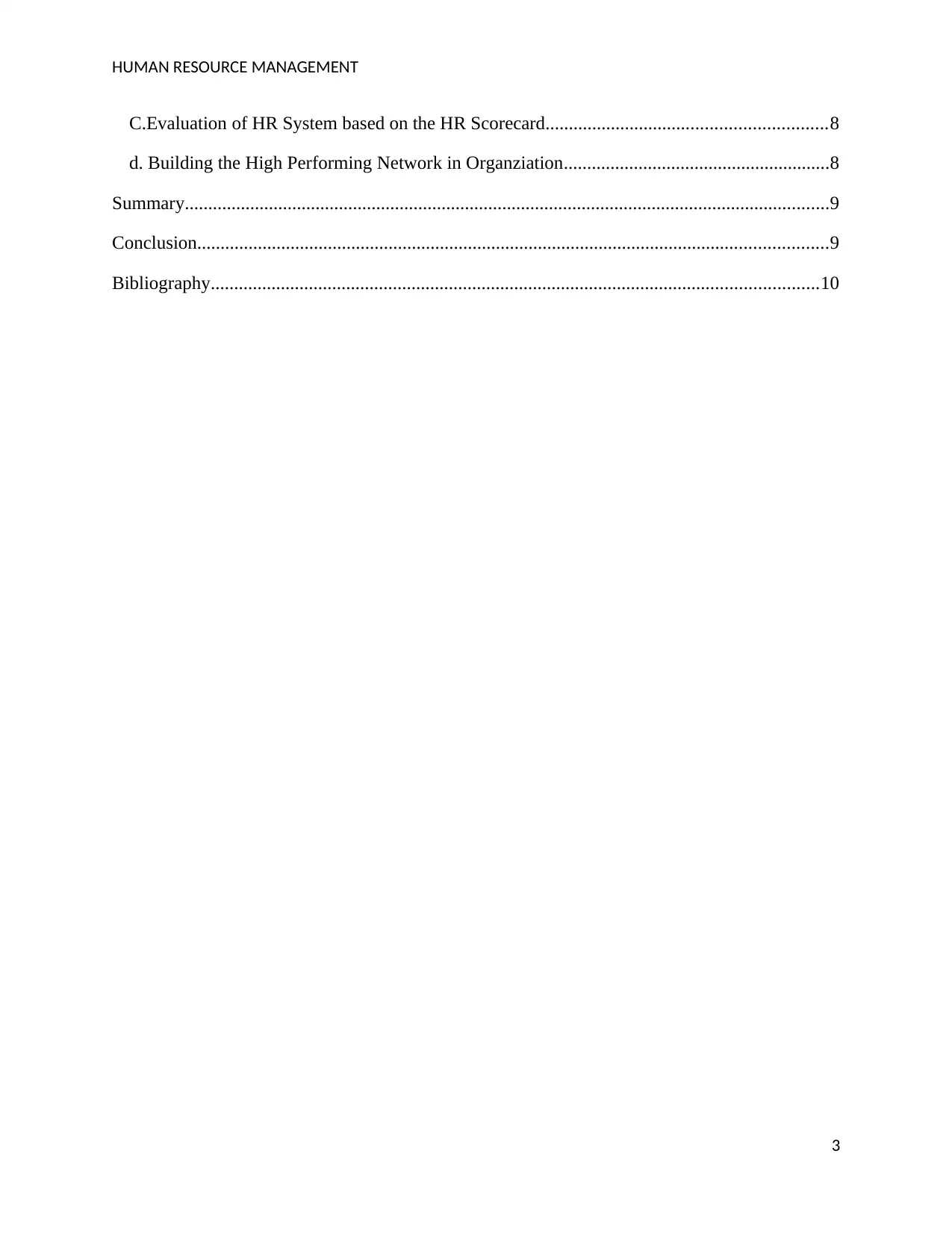
HUMAN RESOURCE MANAGEMENT
C.Evaluation of HR System based on the HR Scorecard............................................................8
d. Building the High Performing Network in Organziation.........................................................8
Summary..........................................................................................................................................9
Conclusion.......................................................................................................................................9
Bibliography..................................................................................................................................10
3
C.Evaluation of HR System based on the HR Scorecard............................................................8
d. Building the High Performing Network in Organziation.........................................................8
Summary..........................................................................................................................................9
Conclusion.......................................................................................................................................9
Bibliography..................................................................................................................................10
3
⊘ This is a preview!⊘
Do you want full access?
Subscribe today to unlock all pages.

Trusted by 1+ million students worldwide
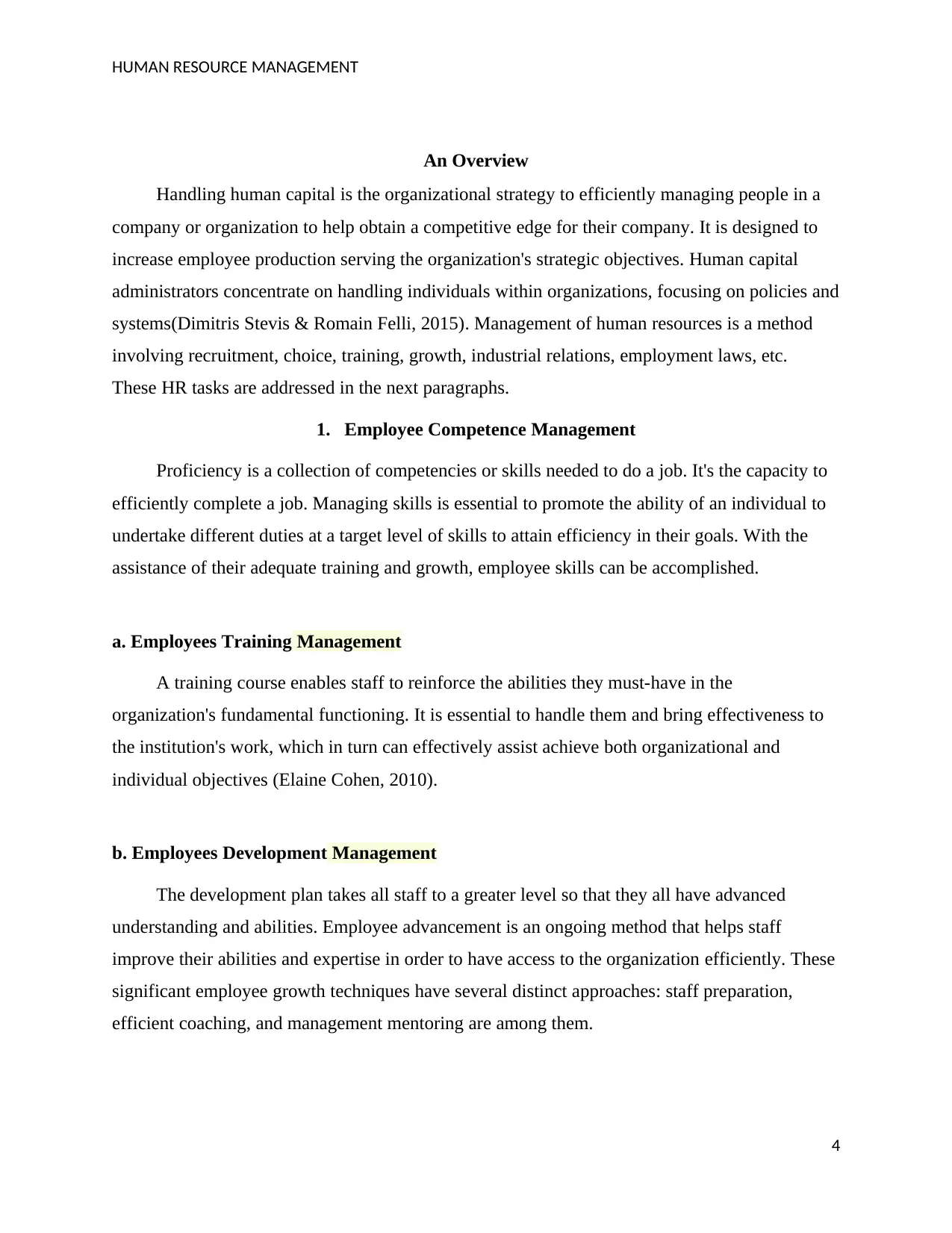
HUMAN RESOURCE MANAGEMENT
An Overview
Handling human capital is the organizational strategy to efficiently managing people in a
company or organization to help obtain a competitive edge for their company. It is designed to
increase employee production serving the organization's strategic objectives. Human capital
administrators concentrate on handling individuals within organizations, focusing on policies and
systems(Dimitris Stevis & Romain Felli, 2015). Management of human resources is a method
involving recruitment, choice, training, growth, industrial relations, employment laws, etc.
These HR tasks are addressed in the next paragraphs.
1. Employee Competence Management
Proficiency is a collection of competencies or skills needed to do a job. It's the capacity to
efficiently complete a job. Managing skills is essential to promote the ability of an individual to
undertake different duties at a target level of skills to attain efficiency in their goals. With the
assistance of their adequate training and growth, employee skills can be accomplished.
a. Employees Training Management
A training course enables staff to reinforce the abilities they must-have in the
organization's fundamental functioning. It is essential to handle them and bring effectiveness to
the institution's work, which in turn can effectively assist achieve both organizational and
individual objectives (Elaine Cohen, 2010).
b. Employees Development Management
The development plan takes all staff to a greater level so that they all have advanced
understanding and abilities. Employee advancement is an ongoing method that helps staff
improve their abilities and expertise in order to have access to the organization efficiently. These
significant employee growth techniques have several distinct approaches: staff preparation,
efficient coaching, and management mentoring are among them.
4
An Overview
Handling human capital is the organizational strategy to efficiently managing people in a
company or organization to help obtain a competitive edge for their company. It is designed to
increase employee production serving the organization's strategic objectives. Human capital
administrators concentrate on handling individuals within organizations, focusing on policies and
systems(Dimitris Stevis & Romain Felli, 2015). Management of human resources is a method
involving recruitment, choice, training, growth, industrial relations, employment laws, etc.
These HR tasks are addressed in the next paragraphs.
1. Employee Competence Management
Proficiency is a collection of competencies or skills needed to do a job. It's the capacity to
efficiently complete a job. Managing skills is essential to promote the ability of an individual to
undertake different duties at a target level of skills to attain efficiency in their goals. With the
assistance of their adequate training and growth, employee skills can be accomplished.
a. Employees Training Management
A training course enables staff to reinforce the abilities they must-have in the
organization's fundamental functioning. It is essential to handle them and bring effectiveness to
the institution's work, which in turn can effectively assist achieve both organizational and
individual objectives (Elaine Cohen, 2010).
b. Employees Development Management
The development plan takes all staff to a greater level so that they all have advanced
understanding and abilities. Employee advancement is an ongoing method that helps staff
improve their abilities and expertise in order to have access to the organization efficiently. These
significant employee growth techniques have several distinct approaches: staff preparation,
efficient coaching, and management mentoring are among them.
4
Paraphrase This Document
Need a fresh take? Get an instant paraphrase of this document with our AI Paraphraser
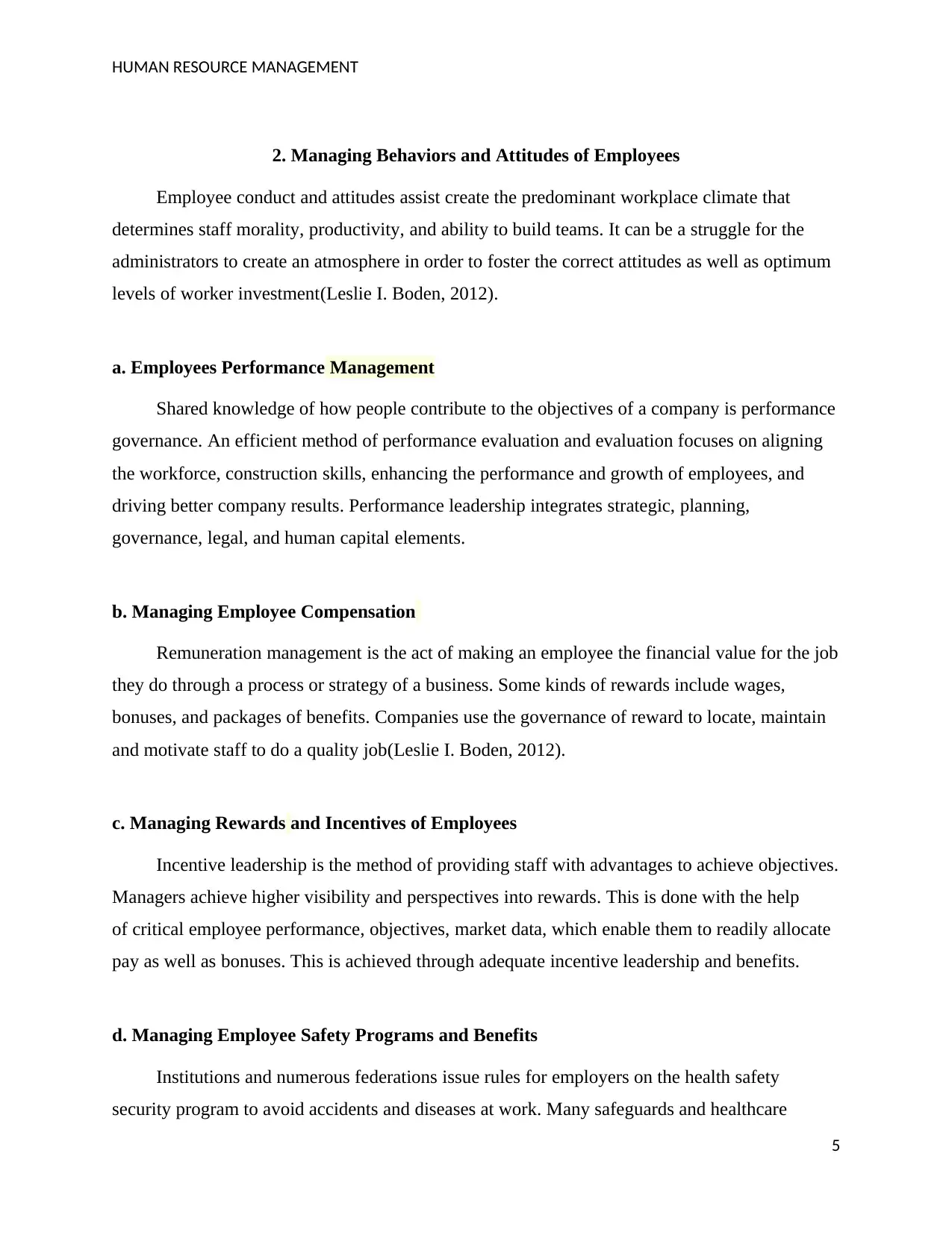
HUMAN RESOURCE MANAGEMENT
2. Managing Behaviors and Attitudes of Employees
Employee conduct and attitudes assist create the predominant workplace climate that
determines staff morality, productivity, and ability to build teams. It can be a struggle for the
administrators to create an atmosphere in order to foster the correct attitudes as well as optimum
levels of worker investment(Leslie I. Boden, 2012).
a. Employees Performance Management
Shared knowledge of how people contribute to the objectives of a company is performance
governance. An efficient method of performance evaluation and evaluation focuses on aligning
the workforce, construction skills, enhancing the performance and growth of employees, and
driving better company results. Performance leadership integrates strategic, planning,
governance, legal, and human capital elements.
b. Managing Employee Compensation
Remuneration management is the act of making an employee the financial value for the job
they do through a process or strategy of a business. Some kinds of rewards include wages,
bonuses, and packages of benefits. Companies use the governance of reward to locate, maintain
and motivate staff to do a quality job(Leslie I. Boden, 2012).
c. Managing Rewards and Incentives of Employees
Incentive leadership is the method of providing staff with advantages to achieve objectives.
Managers achieve higher visibility and perspectives into rewards. This is done with the help
of critical employee performance, objectives, market data, which enable them to readily allocate
pay as well as bonuses. This is achieved through adequate incentive leadership and benefits.
d. Managing Employee Safety Programs and Benefits
Institutions and numerous federations issue rules for employers on the health safety
security program to avoid accidents and diseases at work. Many safeguards and healthcare
5
2. Managing Behaviors and Attitudes of Employees
Employee conduct and attitudes assist create the predominant workplace climate that
determines staff morality, productivity, and ability to build teams. It can be a struggle for the
administrators to create an atmosphere in order to foster the correct attitudes as well as optimum
levels of worker investment(Leslie I. Boden, 2012).
a. Employees Performance Management
Shared knowledge of how people contribute to the objectives of a company is performance
governance. An efficient method of performance evaluation and evaluation focuses on aligning
the workforce, construction skills, enhancing the performance and growth of employees, and
driving better company results. Performance leadership integrates strategic, planning,
governance, legal, and human capital elements.
b. Managing Employee Compensation
Remuneration management is the act of making an employee the financial value for the job
they do through a process or strategy of a business. Some kinds of rewards include wages,
bonuses, and packages of benefits. Companies use the governance of reward to locate, maintain
and motivate staff to do a quality job(Leslie I. Boden, 2012).
c. Managing Rewards and Incentives of Employees
Incentive leadership is the method of providing staff with advantages to achieve objectives.
Managers achieve higher visibility and perspectives into rewards. This is done with the help
of critical employee performance, objectives, market data, which enable them to readily allocate
pay as well as bonuses. This is achieved through adequate incentive leadership and benefits.
d. Managing Employee Safety Programs and Benefits
Institutions and numerous federations issue rules for employers on the health safety
security program to avoid accidents and diseases at work. Many safeguards and healthcare
5
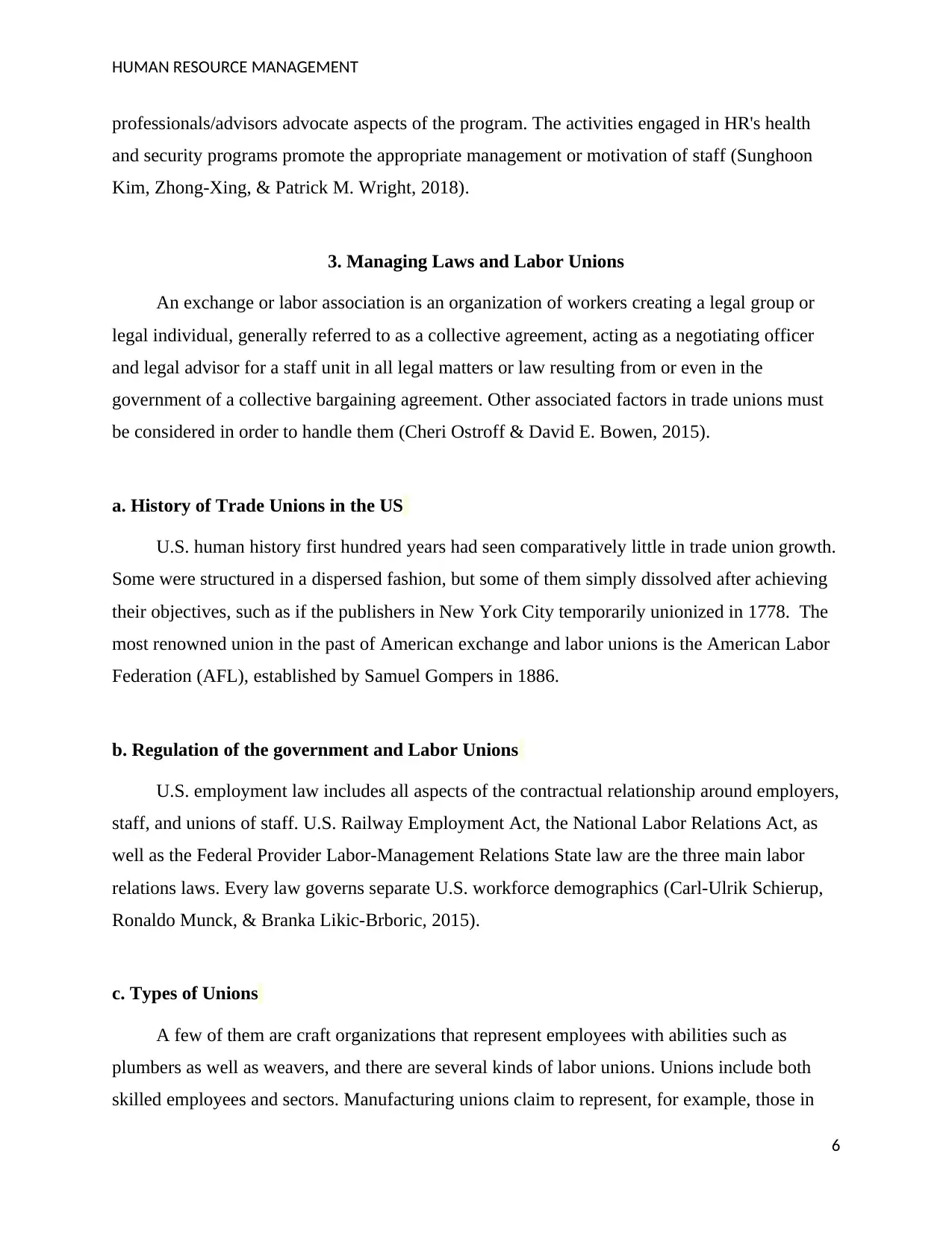
HUMAN RESOURCE MANAGEMENT
professionals/advisors advocate aspects of the program. The activities engaged in HR's health
and security programs promote the appropriate management or motivation of staff (Sunghoon
Kim, Zhong‐Xing, & Patrick M. Wright, 2018).
3. Managing Laws and Labor Unions
An exchange or labor association is an organization of workers creating a legal group or
legal individual, generally referred to as a collective agreement, acting as a negotiating officer
and legal advisor for a staff unit in all legal matters or law resulting from or even in the
government of a collective bargaining agreement. Other associated factors in trade unions must
be considered in order to handle them (Cheri Ostroff & David E. Bowen, 2015).
a. History of Trade Unions in the US
U.S. human history first hundred years had seen comparatively little in trade union growth.
Some were structured in a dispersed fashion, but some of them simply dissolved after achieving
their objectives, such as if the publishers in New York City temporarily unionized in 1778. The
most renowned union in the past of American exchange and labor unions is the American Labor
Federation (AFL), established by Samuel Gompers in 1886.
b. Regulation of the government and Labor Unions
U.S. employment law includes all aspects of the contractual relationship around employers,
staff, and unions of staff. U.S. Railway Employment Act, the National Labor Relations Act, as
well as the Federal Provider Labor-Management Relations State law are the three main labor
relations laws. Every law governs separate U.S. workforce demographics (Carl-Ulrik Schierup,
Ronaldo Munck, & Branka Likic-Brboric, 2015).
c. Types of Unions
A few of them are craft organizations that represent employees with abilities such as
plumbers as well as weavers, and there are several kinds of labor unions. Unions include both
skilled employees and sectors. Manufacturing unions claim to represent, for example, those in
6
professionals/advisors advocate aspects of the program. The activities engaged in HR's health
and security programs promote the appropriate management or motivation of staff (Sunghoon
Kim, Zhong‐Xing, & Patrick M. Wright, 2018).
3. Managing Laws and Labor Unions
An exchange or labor association is an organization of workers creating a legal group or
legal individual, generally referred to as a collective agreement, acting as a negotiating officer
and legal advisor for a staff unit in all legal matters or law resulting from or even in the
government of a collective bargaining agreement. Other associated factors in trade unions must
be considered in order to handle them (Cheri Ostroff & David E. Bowen, 2015).
a. History of Trade Unions in the US
U.S. human history first hundred years had seen comparatively little in trade union growth.
Some were structured in a dispersed fashion, but some of them simply dissolved after achieving
their objectives, such as if the publishers in New York City temporarily unionized in 1778. The
most renowned union in the past of American exchange and labor unions is the American Labor
Federation (AFL), established by Samuel Gompers in 1886.
b. Regulation of the government and Labor Unions
U.S. employment law includes all aspects of the contractual relationship around employers,
staff, and unions of staff. U.S. Railway Employment Act, the National Labor Relations Act, as
well as the Federal Provider Labor-Management Relations State law are the three main labor
relations laws. Every law governs separate U.S. workforce demographics (Carl-Ulrik Schierup,
Ronaldo Munck, & Branka Likic-Brboric, 2015).
c. Types of Unions
A few of them are craft organizations that represent employees with abilities such as
plumbers as well as weavers, and there are several kinds of labor unions. Unions include both
skilled employees and sectors. Manufacturing unions claim to represent, for example, those in
6
⊘ This is a preview!⊘
Do you want full access?
Subscribe today to unlock all pages.

Trusted by 1+ million students worldwide
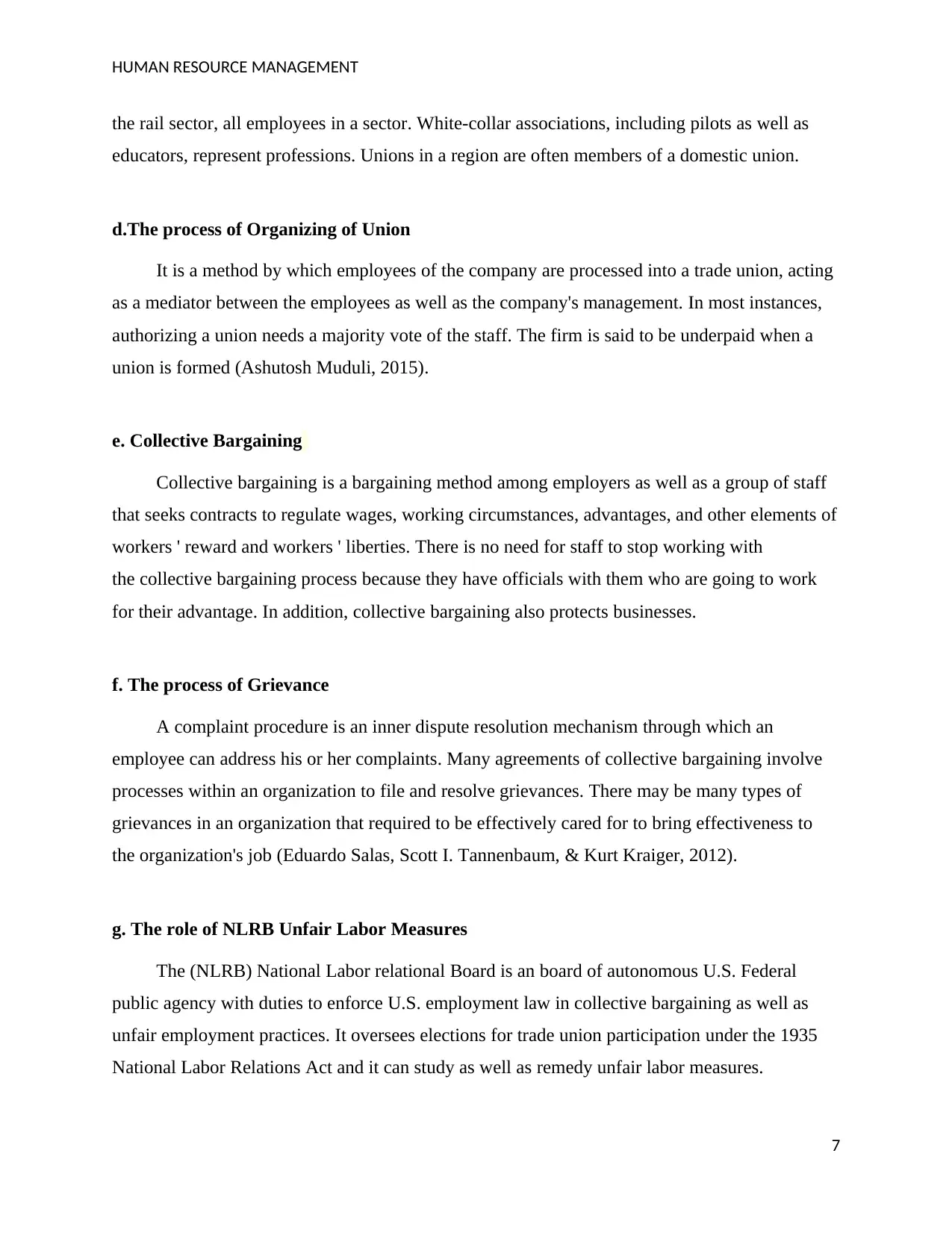
HUMAN RESOURCE MANAGEMENT
the rail sector, all employees in a sector. White-collar associations, including pilots as well as
educators, represent professions. Unions in a region are often members of a domestic union.
d.The process of Organizing of Union
It is a method by which employees of the company are processed into a trade union, acting
as a mediator between the employees as well as the company's management. In most instances,
authorizing a union needs a majority vote of the staff. The firm is said to be underpaid when a
union is formed (Ashutosh Muduli, 2015).
e. Collective Bargaining
Collective bargaining is a bargaining method among employers as well as a group of staff
that seeks contracts to regulate wages, working circumstances, advantages, and other elements of
workers ' reward and workers ' liberties. There is no need for staff to stop working with
the collective bargaining process because they have officials with them who are going to work
for their advantage. In addition, collective bargaining also protects businesses.
f. The process of Grievance
A complaint procedure is an inner dispute resolution mechanism through which an
employee can address his or her complaints. Many agreements of collective bargaining involve
processes within an organization to file and resolve grievances. There may be many types of
grievances in an organization that required to be effectively cared for to bring effectiveness to
the organization's job (Eduardo Salas, Scott I. Tannenbaum, & Kurt Kraiger, 2012).
g. The role of NLRB Unfair Labor Measures
The (NLRB) National Labor relational Board is an board of autonomous U.S. Federal
public agency with duties to enforce U.S. employment law in collective bargaining as well as
unfair employment practices. It oversees elections for trade union participation under the 1935
National Labor Relations Act and it can study as well as remedy unfair labor measures.
7
the rail sector, all employees in a sector. White-collar associations, including pilots as well as
educators, represent professions. Unions in a region are often members of a domestic union.
d.The process of Organizing of Union
It is a method by which employees of the company are processed into a trade union, acting
as a mediator between the employees as well as the company's management. In most instances,
authorizing a union needs a majority vote of the staff. The firm is said to be underpaid when a
union is formed (Ashutosh Muduli, 2015).
e. Collective Bargaining
Collective bargaining is a bargaining method among employers as well as a group of staff
that seeks contracts to regulate wages, working circumstances, advantages, and other elements of
workers ' reward and workers ' liberties. There is no need for staff to stop working with
the collective bargaining process because they have officials with them who are going to work
for their advantage. In addition, collective bargaining also protects businesses.
f. The process of Grievance
A complaint procedure is an inner dispute resolution mechanism through which an
employee can address his or her complaints. Many agreements of collective bargaining involve
processes within an organization to file and resolve grievances. There may be many types of
grievances in an organization that required to be effectively cared for to bring effectiveness to
the organization's job (Eduardo Salas, Scott I. Tannenbaum, & Kurt Kraiger, 2012).
g. The role of NLRB Unfair Labor Measures
The (NLRB) National Labor relational Board is an board of autonomous U.S. Federal
public agency with duties to enforce U.S. employment law in collective bargaining as well as
unfair employment practices. It oversees elections for trade union participation under the 1935
National Labor Relations Act and it can study as well as remedy unfair labor measures.
7
Paraphrase This Document
Need a fresh take? Get an instant paraphrase of this document with our AI Paraphraser
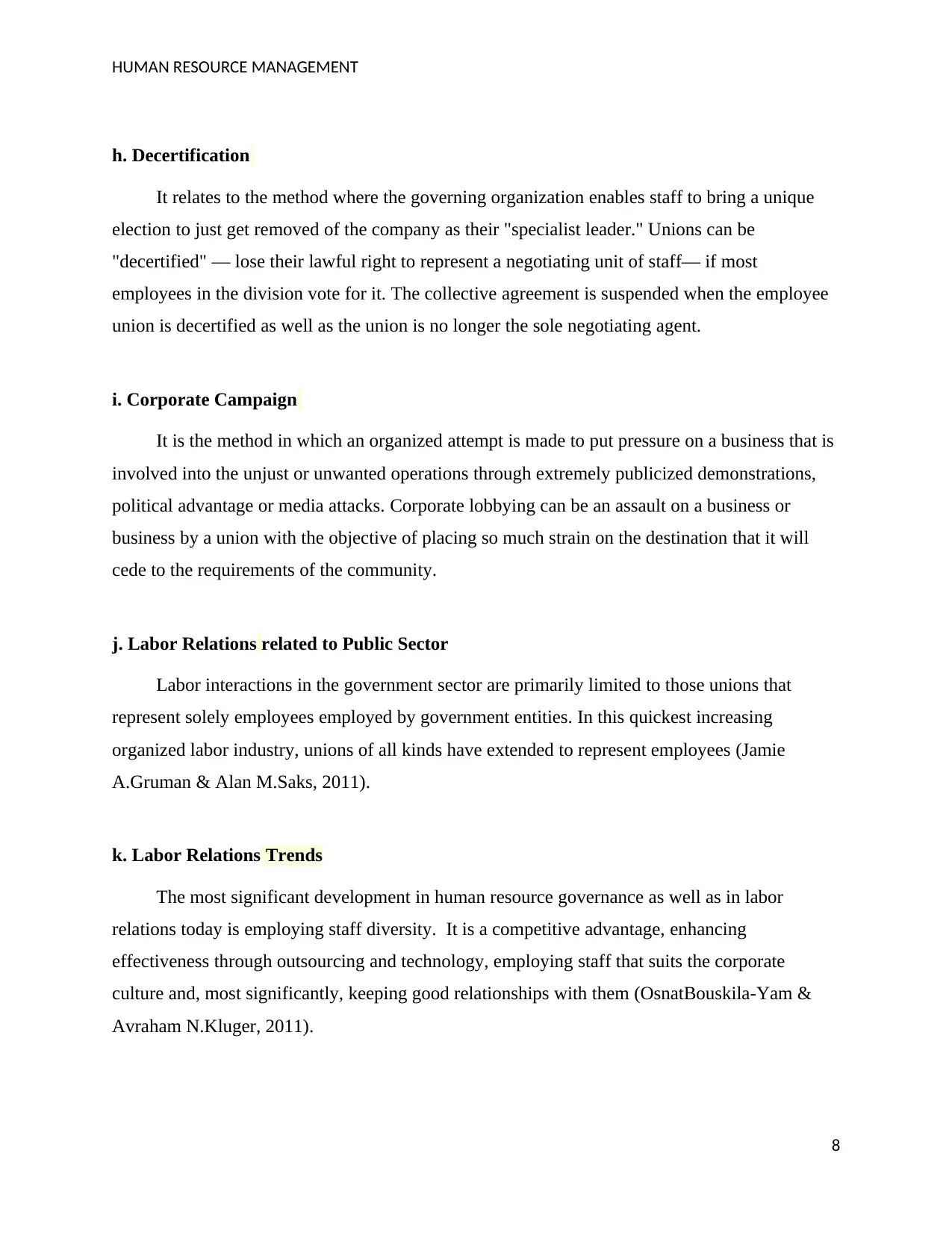
HUMAN RESOURCE MANAGEMENT
h. Decertification
It relates to the method where the governing organization enables staff to bring a unique
election to just get removed of the company as their "specialist leader." Unions can be
"decertified" — lose their lawful right to represent a negotiating unit of staff— if most
employees in the division vote for it. The collective agreement is suspended when the employee
union is decertified as well as the union is no longer the sole negotiating agent.
i. Corporate Campaign
It is the method in which an organized attempt is made to put pressure on a business that is
involved into the unjust or unwanted operations through extremely publicized demonstrations,
political advantage or media attacks. Corporate lobbying can be an assault on a business or
business by a union with the objective of placing so much strain on the destination that it will
cede to the requirements of the community.
j. Labor Relations related to Public Sector
Labor interactions in the government sector are primarily limited to those unions that
represent solely employees employed by government entities. In this quickest increasing
organized labor industry, unions of all kinds have extended to represent employees (Jamie
A.Gruman & Alan M.Saks, 2011).
k. Labor Relations Trends
The most significant development in human resource governance as well as in labor
relations today is employing staff diversity. It is a competitive advantage, enhancing
effectiveness through outsourcing and technology, employing staff that suits the corporate
culture and, most significantly, keeping good relationships with them (OsnatBouskila-Yam &
Avraham N.Kluger, 2011).
8
h. Decertification
It relates to the method where the governing organization enables staff to bring a unique
election to just get removed of the company as their "specialist leader." Unions can be
"decertified" — lose their lawful right to represent a negotiating unit of staff— if most
employees in the division vote for it. The collective agreement is suspended when the employee
union is decertified as well as the union is no longer the sole negotiating agent.
i. Corporate Campaign
It is the method in which an organized attempt is made to put pressure on a business that is
involved into the unjust or unwanted operations through extremely publicized demonstrations,
political advantage or media attacks. Corporate lobbying can be an assault on a business or
business by a union with the objective of placing so much strain on the destination that it will
cede to the requirements of the community.
j. Labor Relations related to Public Sector
Labor interactions in the government sector are primarily limited to those unions that
represent solely employees employed by government entities. In this quickest increasing
organized labor industry, unions of all kinds have extended to represent employees (Jamie
A.Gruman & Alan M.Saks, 2011).
k. Labor Relations Trends
The most significant development in human resource governance as well as in labor
relations today is employing staff diversity. It is a competitive advantage, enhancing
effectiveness through outsourcing and technology, employing staff that suits the corporate
culture and, most significantly, keeping good relationships with them (OsnatBouskila-Yam &
Avraham N.Kluger, 2011).
8
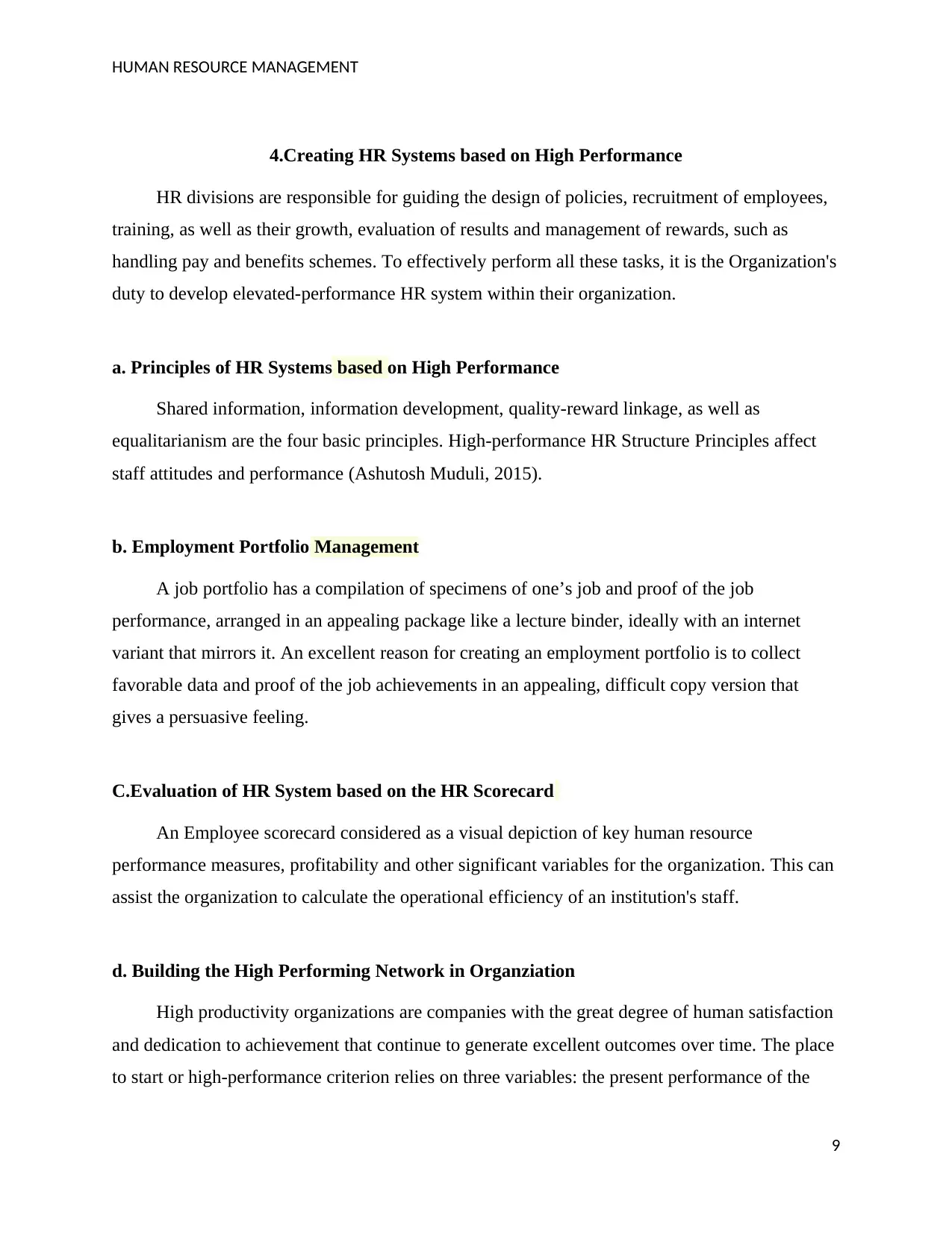
HUMAN RESOURCE MANAGEMENT
4.Creating HR Systems based on High Performance
HR divisions are responsible for guiding the design of policies, recruitment of employees,
training, as well as their growth, evaluation of results and management of rewards, such as
handling pay and benefits schemes. To effectively perform all these tasks, it is the Organization's
duty to develop elevated-performance HR system within their organization.
a. Principles of HR Systems based on High Performance
Shared information, information development, quality-reward linkage, as well as
equalitarianism are the four basic principles. High-performance HR Structure Principles affect
staff attitudes and performance (Ashutosh Muduli, 2015).
b. Employment Portfolio Management
A job portfolio has a compilation of specimens of one’s job and proof of the job
performance, arranged in an appealing package like a lecture binder, ideally with an internet
variant that mirrors it. An excellent reason for creating an employment portfolio is to collect
favorable data and proof of the job achievements in an appealing, difficult copy version that
gives a persuasive feeling.
C.Evaluation of HR System based on the HR Scorecard
An Employee scorecard considered as a visual depiction of key human resource
performance measures, profitability and other significant variables for the organization. This can
assist the organization to calculate the operational efficiency of an institution's staff.
d. Building the High Performing Network in Organziation
High productivity organizations are companies with the great degree of human satisfaction
and dedication to achievement that continue to generate excellent outcomes over time. The place
to start or high-performance criterion relies on three variables: the present performance of the
9
4.Creating HR Systems based on High Performance
HR divisions are responsible for guiding the design of policies, recruitment of employees,
training, as well as their growth, evaluation of results and management of rewards, such as
handling pay and benefits schemes. To effectively perform all these tasks, it is the Organization's
duty to develop elevated-performance HR system within their organization.
a. Principles of HR Systems based on High Performance
Shared information, information development, quality-reward linkage, as well as
equalitarianism are the four basic principles. High-performance HR Structure Principles affect
staff attitudes and performance (Ashutosh Muduli, 2015).
b. Employment Portfolio Management
A job portfolio has a compilation of specimens of one’s job and proof of the job
performance, arranged in an appealing package like a lecture binder, ideally with an internet
variant that mirrors it. An excellent reason for creating an employment portfolio is to collect
favorable data and proof of the job achievements in an appealing, difficult copy version that
gives a persuasive feeling.
C.Evaluation of HR System based on the HR Scorecard
An Employee scorecard considered as a visual depiction of key human resource
performance measures, profitability and other significant variables for the organization. This can
assist the organization to calculate the operational efficiency of an institution's staff.
d. Building the High Performing Network in Organziation
High productivity organizations are companies with the great degree of human satisfaction
and dedication to achievement that continue to generate excellent outcomes over time. The place
to start or high-performance criterion relies on three variables: the present performance of the
9
⊘ This is a preview!⊘
Do you want full access?
Subscribe today to unlock all pages.

Trusted by 1+ million students worldwide
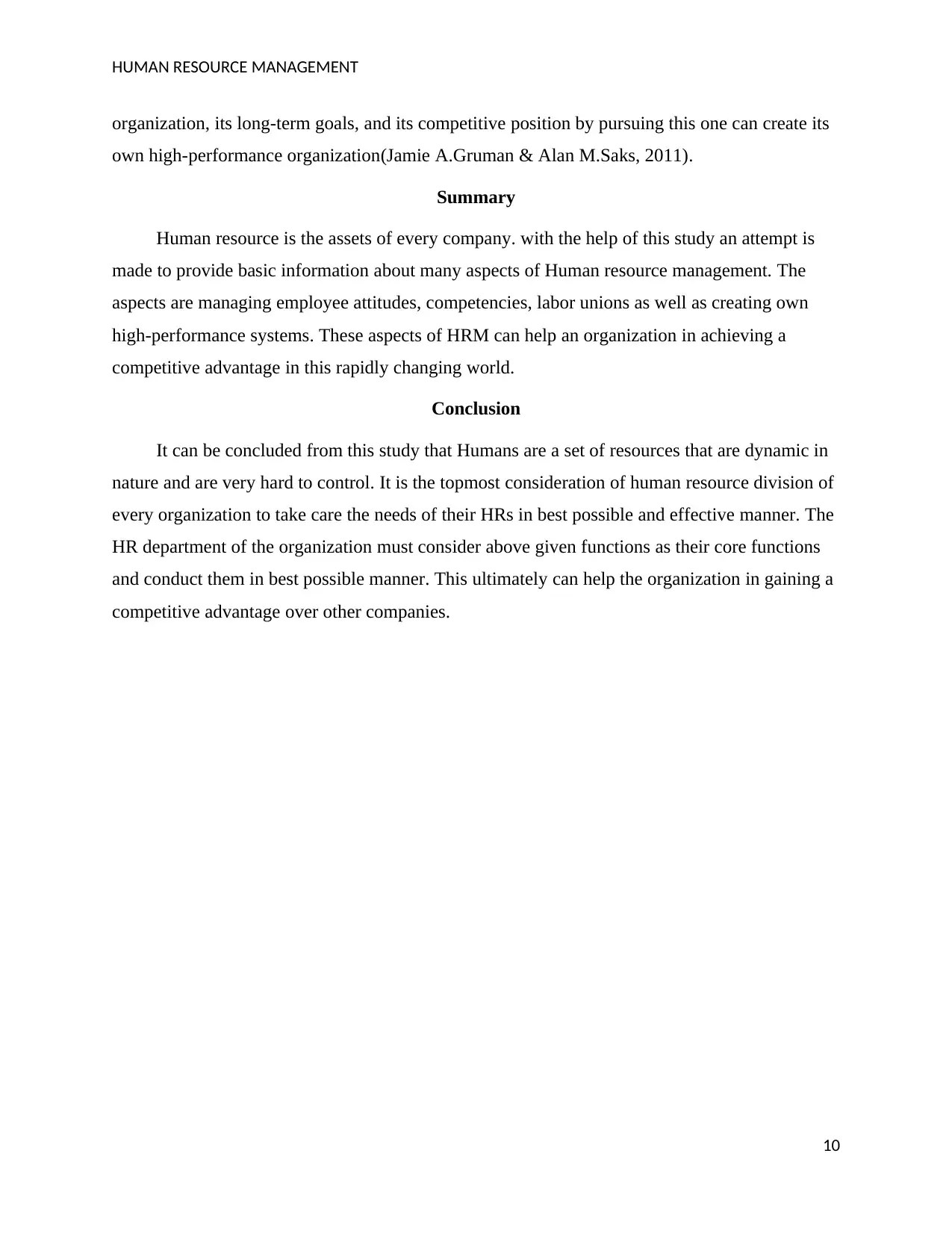
HUMAN RESOURCE MANAGEMENT
organization, its long-term goals, and its competitive position by pursuing this one can create its
own high-performance organization(Jamie A.Gruman & Alan M.Saks, 2011).
Summary
Human resource is the assets of every company. with the help of this study an attempt is
made to provide basic information about many aspects of Human resource management. The
aspects are managing employee attitudes, competencies, labor unions as well as creating own
high-performance systems. These aspects of HRM can help an organization in achieving a
competitive advantage in this rapidly changing world.
Conclusion
It can be concluded from this study that Humans are a set of resources that are dynamic in
nature and are very hard to control. It is the topmost consideration of human resource division of
every organization to take care the needs of their HRs in best possible and effective manner. The
HR department of the organization must consider above given functions as their core functions
and conduct them in best possible manner. This ultimately can help the organization in gaining a
competitive advantage over other companies.
10
organization, its long-term goals, and its competitive position by pursuing this one can create its
own high-performance organization(Jamie A.Gruman & Alan M.Saks, 2011).
Summary
Human resource is the assets of every company. with the help of this study an attempt is
made to provide basic information about many aspects of Human resource management. The
aspects are managing employee attitudes, competencies, labor unions as well as creating own
high-performance systems. These aspects of HRM can help an organization in achieving a
competitive advantage in this rapidly changing world.
Conclusion
It can be concluded from this study that Humans are a set of resources that are dynamic in
nature and are very hard to control. It is the topmost consideration of human resource division of
every organization to take care the needs of their HRs in best possible and effective manner. The
HR department of the organization must consider above given functions as their core functions
and conduct them in best possible manner. This ultimately can help the organization in gaining a
competitive advantage over other companies.
10
Paraphrase This Document
Need a fresh take? Get an instant paraphrase of this document with our AI Paraphraser
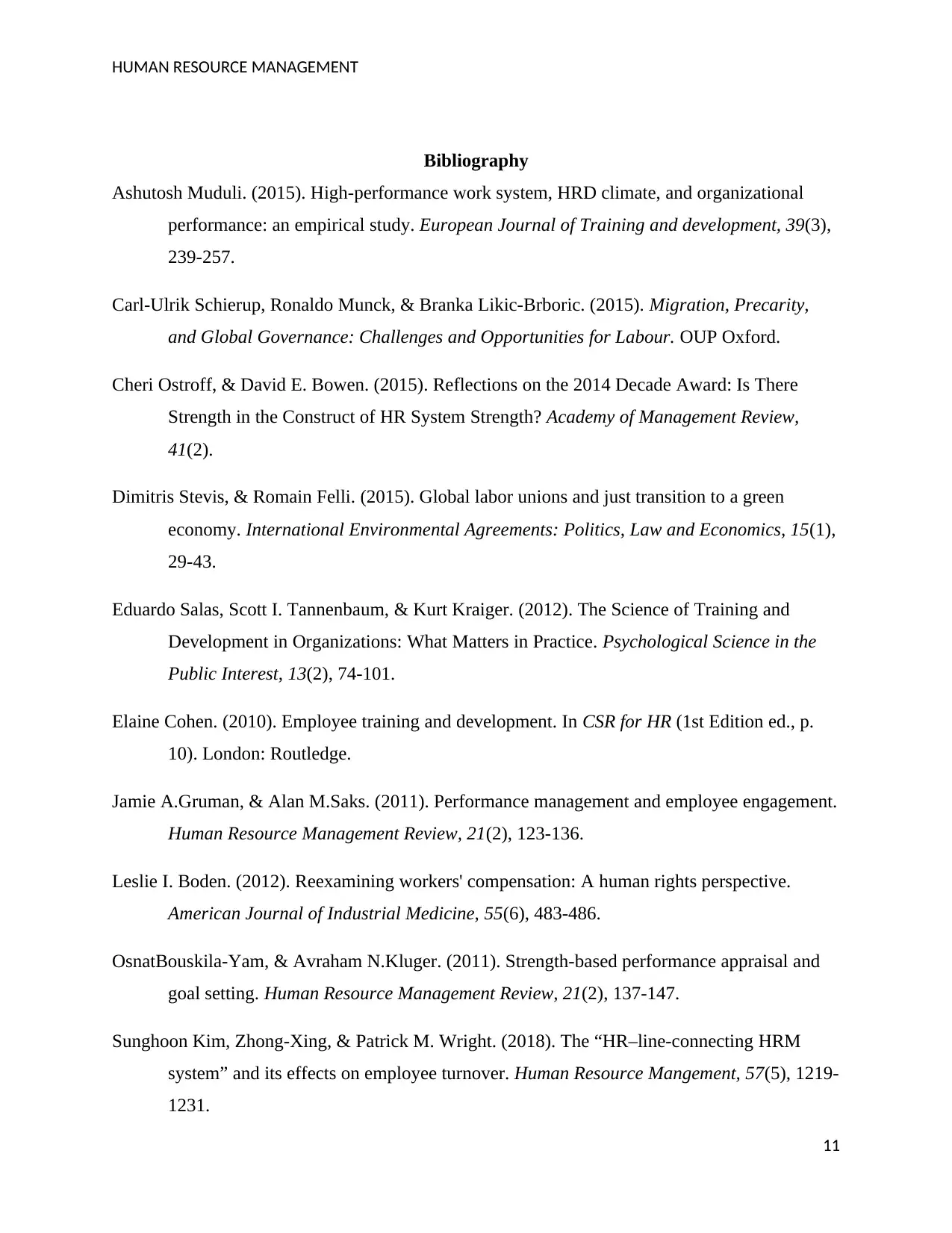
HUMAN RESOURCE MANAGEMENT
Bibliography
Ashutosh Muduli. (2015). High-performance work system, HRD climate, and organizational
performance: an empirical study. European Journal of Training and development, 39(3),
239-257.
Carl-Ulrik Schierup, Ronaldo Munck, & Branka Likic-Brboric. (2015). Migration, Precarity,
and Global Governance: Challenges and Opportunities for Labour. OUP Oxford.
Cheri Ostroff, & David E. Bowen. (2015). Reflections on the 2014 Decade Award: Is There
Strength in the Construct of HR System Strength? Academy of Management Review,
41(2).
Dimitris Stevis, & Romain Felli. (2015). Global labor unions and just transition to a green
economy. International Environmental Agreements: Politics, Law and Economics, 15(1),
29-43.
Eduardo Salas, Scott I. Tannenbaum, & Kurt Kraiger. (2012). The Science of Training and
Development in Organizations: What Matters in Practice. Psychological Science in the
Public Interest, 13(2), 74-101.
Elaine Cohen. (2010). Employee training and development. In CSR for HR (1st Edition ed., p.
10). London: Routledge.
Jamie A.Gruman, & Alan M.Saks. (2011). Performance management and employee engagement.
Human Resource Management Review, 21(2), 123-136.
Leslie I. Boden. (2012). Reexamining workers' compensation: A human rights perspective.
American Journal of Industrial Medicine, 55(6), 483-486.
OsnatBouskila-Yam, & Avraham N.Kluger. (2011). Strength-based performance appraisal and
goal setting. Human Resource Management Review, 21(2), 137-147.
Sunghoon Kim, Zhong‐Xing, & Patrick M. Wright. (2018). The “HR–line‐connecting HRM
system” and its effects on employee turnover. Human Resource Mangement, 57(5), 1219-
1231.
11
Bibliography
Ashutosh Muduli. (2015). High-performance work system, HRD climate, and organizational
performance: an empirical study. European Journal of Training and development, 39(3),
239-257.
Carl-Ulrik Schierup, Ronaldo Munck, & Branka Likic-Brboric. (2015). Migration, Precarity,
and Global Governance: Challenges and Opportunities for Labour. OUP Oxford.
Cheri Ostroff, & David E. Bowen. (2015). Reflections on the 2014 Decade Award: Is There
Strength in the Construct of HR System Strength? Academy of Management Review,
41(2).
Dimitris Stevis, & Romain Felli. (2015). Global labor unions and just transition to a green
economy. International Environmental Agreements: Politics, Law and Economics, 15(1),
29-43.
Eduardo Salas, Scott I. Tannenbaum, & Kurt Kraiger. (2012). The Science of Training and
Development in Organizations: What Matters in Practice. Psychological Science in the
Public Interest, 13(2), 74-101.
Elaine Cohen. (2010). Employee training and development. In CSR for HR (1st Edition ed., p.
10). London: Routledge.
Jamie A.Gruman, & Alan M.Saks. (2011). Performance management and employee engagement.
Human Resource Management Review, 21(2), 123-136.
Leslie I. Boden. (2012). Reexamining workers' compensation: A human rights perspective.
American Journal of Industrial Medicine, 55(6), 483-486.
OsnatBouskila-Yam, & Avraham N.Kluger. (2011). Strength-based performance appraisal and
goal setting. Human Resource Management Review, 21(2), 137-147.
Sunghoon Kim, Zhong‐Xing, & Patrick M. Wright. (2018). The “HR–line‐connecting HRM
system” and its effects on employee turnover. Human Resource Mangement, 57(5), 1219-
1231.
11
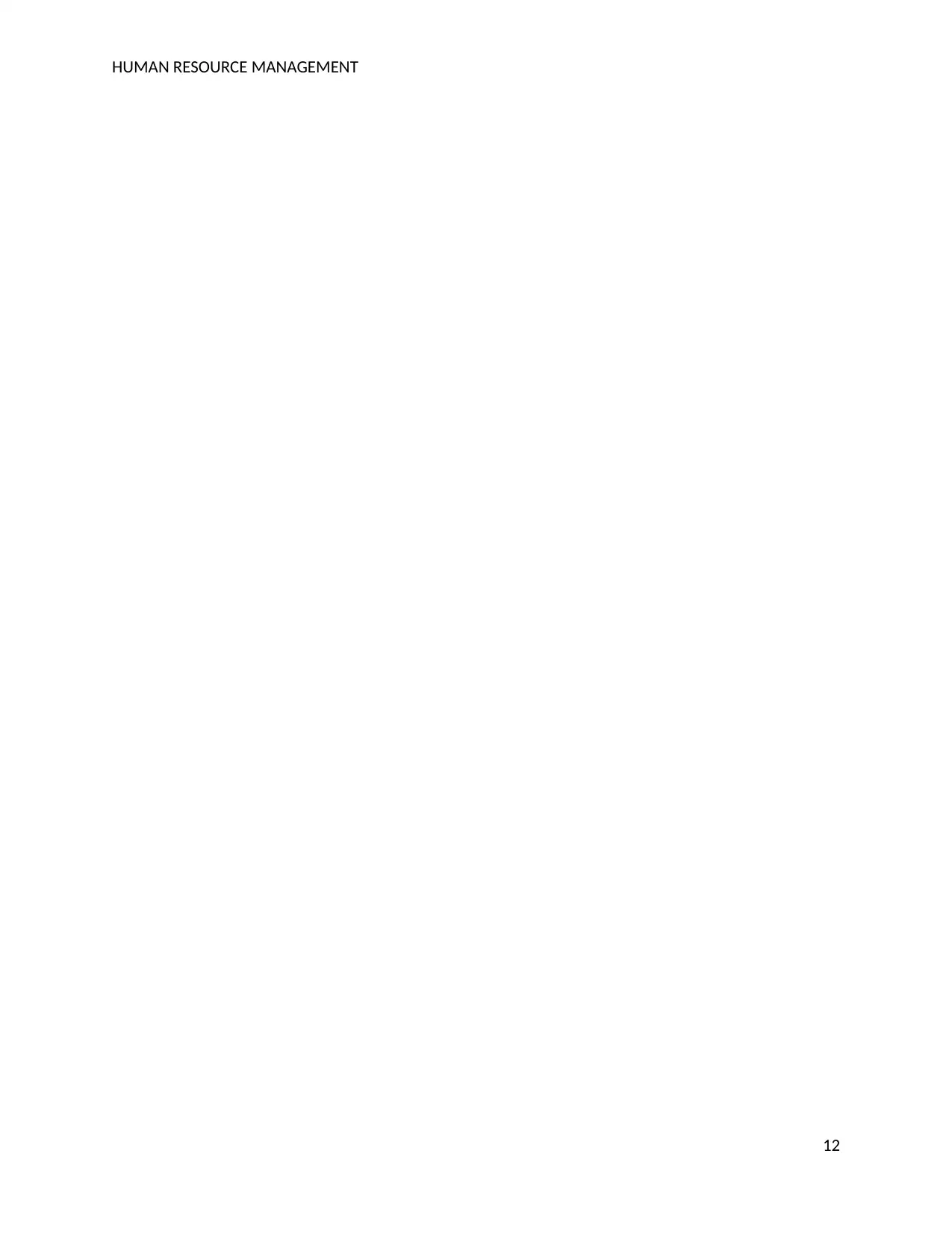
HUMAN RESOURCE MANAGEMENT
12
12
⊘ This is a preview!⊘
Do you want full access?
Subscribe today to unlock all pages.

Trusted by 1+ million students worldwide
1 out of 12
Related Documents
Your All-in-One AI-Powered Toolkit for Academic Success.
+13062052269
info@desklib.com
Available 24*7 on WhatsApp / Email
![[object Object]](/_next/static/media/star-bottom.7253800d.svg)
Unlock your academic potential
Copyright © 2020–2025 A2Z Services. All Rights Reserved. Developed and managed by ZUCOL.





